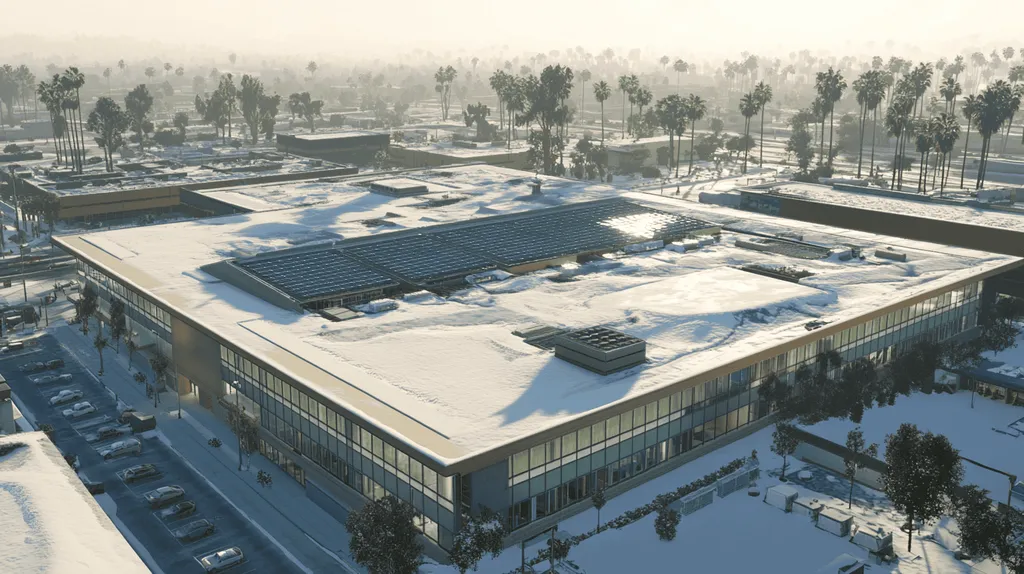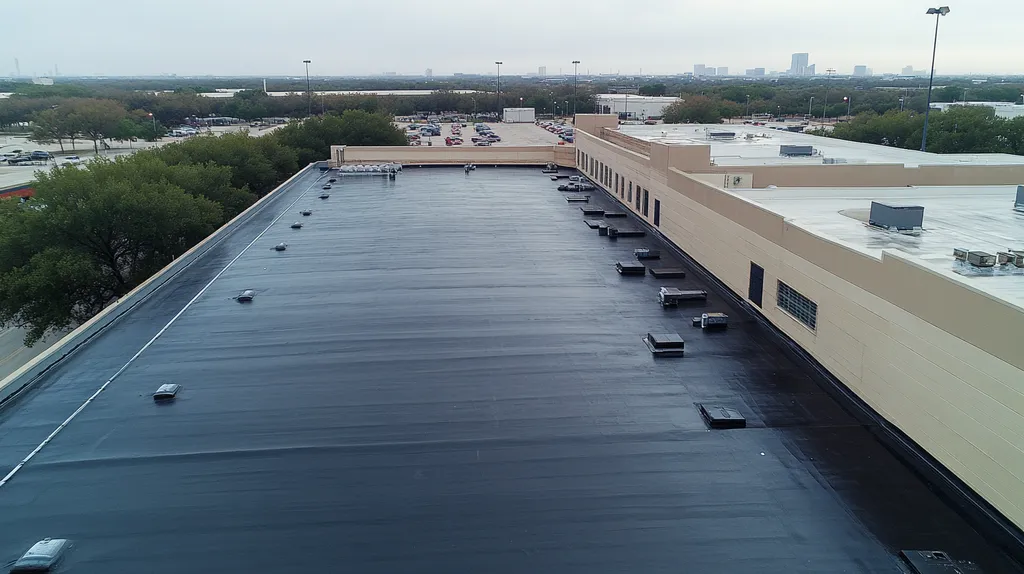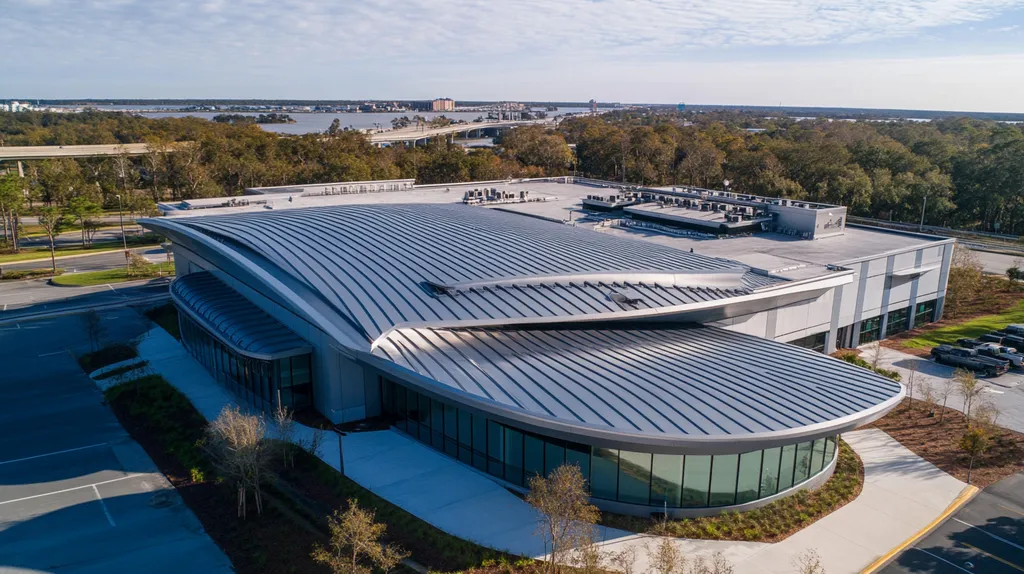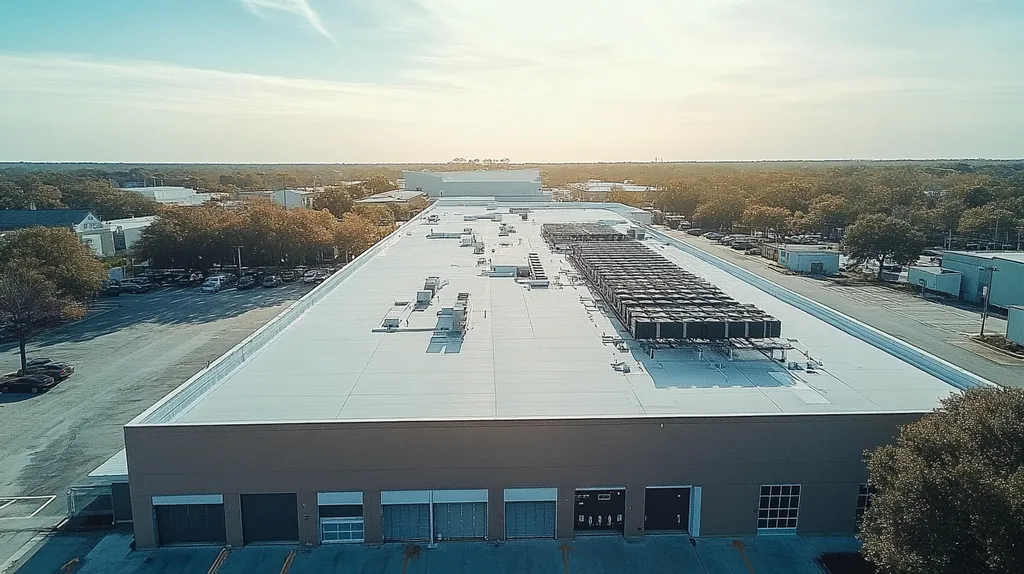The lifespan of an industrial roof has become a critical concern as replacement costs reach record highs, with premature failures now averaging $2-3 million per incident. Industry data shows that 60% of industrial roofs fail before reaching half their designed service life.
Through five decades of documented cases, a clear pattern emerges: misconceptions about roof maintenance consistently lead to catastrophic and costly failures. From the basic tar-and-gravel systems of the 1970s to today’s advanced synthetic membranes, the fundamental principles of roof preservation remain unchanged.
This comprehensive analysis examines how outdated beliefs continue driving decisions that compromise industrial roof performance, while offering evidence-based solutions for extending service life.
SECTION 1: COMMON MISCONCEPTIONS
The evolution of industrial roofing has taught us valuable lessons about longevity and maintenance. In the 1970s, basic tar and gravel systems could last 15-20 years with minimal attention. Today’s advanced roofing systems can extend well beyond 30 years – but only with proper care. Unfortunately, persistent misconceptions continue leading property owners down costly paths, with studies showing premature failures reducing expected lifespans by up to 40%.
Ignoring Regular Inspections
The days of “set it and forget it” industrial roofing are long behind us. Modern roofing systems, while more durable than their predecessors, require consistent monitoring to achieve their full lifespan potential.
Spring and fall inspections serve as the cornerstone of any effective roof maintenance program. These systematic checks allow early detection of issues that, left unchecked, could escalate from minor repairs to major replacements.
Documentation from each inspection builds a valuable performance history. This record helps identify patterns, predict potential failures, and justify timely interventions before small problems become structural threats.
Post-storm inspections have become increasingly critical as weather patterns grow more severe. Even seemingly minor events can compromise roofing components in ways that only trained eyes can detect.
Believing in Quick Fixes
The history of industrial roofing tells us that temporary repairs almost always lead to permanent problems. What begins as a simple patch job often masks deeper issues that continue deteriorating beneath the surface.
Modern roofing materials are engineered as complete systems, not individual components. When one area shows damage, it typically indicates broader stress patterns that require comprehensive evaluation.
The true cost of quick fixes emerges in the form of recurring problems and escalating repair expenses. What might have been addressed with targeted maintenance often develops into full replacement needs.
Professional assessment helps identify the root causes behind visible symptoms. This diagnostic approach leads to lasting solutions rather than perpetual patch cycles.
Overlooking Drainage Issues
Water remains the primary enemy of every industrial roof, yet drainage often receives insufficient attention. Poor drainage accelerates material degradation and can compromise structural integrity long before visible damage appears.
Proper drainage design must account for local rainfall patterns, roof geometry, and building use. Even minor ponding can indicate serious underlying issues that demand immediate attention.
Water pooling on an industrial roof is a sign of poor drainage, which can lead to premature wear, leaks, and even structural failure. Regular maintenance of gutters and downspouts, combined with proper slope management, prevents these issues from developing. (source: Meredith Plays)
Modern drainage solutions often incorporate redundant systems and monitoring technology. These advances help prevent the catastrophic failures that historically plagued industrial facilities.
SECTION 2: PRACTICAL IMPLICATIONS
The aging of industrial roofs illustrates a stark reality in modern facility management. What began as simple shelter systems in the mid-20th century have evolved into complex assemblies demanding careful attention. Today’s industrial roofs face unprecedented challenges, from extreme weather events to rising energy costs, making their proper maintenance more critical than ever.
Impact on Roof Longevity
Industrial roofs are constantly exposed to extreme weather, from heavy rain and snow to intense heat and UV radiation. These environmental stresses accelerate aging, particularly when combined with inadequate maintenance practices.
Regular inspections, particularly in spring and fall, serve as essential early warning systems. These evaluations help identify potential issues before they develop into major structural problems.
Keeping the roof clean and maintaining proper drainage prevents the accumulation of damaging materials. Even seemingly minor debris can trap moisture and accelerate deterioration of roofing components.
UV-resistant coatings and proper ventilation systems have become crucial tools in extending roof life. These protective measures help mitigate weather-related damage that historically plagued industrial facilities. (source: Meredith Plays)
Effects on Building Integrity
Modern industrial buildings rely on their roofs for more than just weather protection. These systems integrate closely with structural supports, mechanical systems, and building envelope components.
When roofing systems begin to fail, the damage rarely stays contained. Water infiltration can compromise structural steel, destroy insulation, and create dangerous conditions for building occupants.
The interaction between roof condition and building structure has become increasingly complex. Today’s facilities often house sensitive equipment and processes that require precise environmental control.
Historical examples from the past fifty years demonstrate how seemingly minor roofing issues can cascade into catastrophic building failures. These lessons continue shaping current approaches to structural preservation.
Consequences for Energy Efficiency
The evolution of energy costs has transformed industrial roofing from simple weather barriers into critical components of building efficiency. Modern systems must actively contribute to temperature regulation and climate control.
Deteriorating roofs consistently rank among the top sources of industrial energy waste. Even minor compromises in roof integrity can lead to significant increases in heating and cooling costs.
Advanced materials and installation techniques now offer unprecedented opportunities for energy savings. These innovations build upon decades of research into thermal performance and environmental impact.
The relationship between roof condition and energy consumption continues growing more direct. Today’s facility managers must balance immediate maintenance costs against long-term energy implications.
SECTION 3: COST OF MISINFORMATION
The evolution of industrial roofing knowledge has revealed stark financial realities. While roofing technology has advanced dramatically since the 1970s, persistent myths continue driving costly decisions. Studies show that misinformation-driven maintenance errors now account for over 60% of premature industrial roof failures, with repair costs often exceeding initial installation expenses.
Financial Burden of Repairs
The true cost of roofing repairs extends far beyond initial estimates. Modern industrial roofing systems represent significant capital investments, with replacement costs routinely reaching millions of dollars for large facilities.
Early detection of potential issues through proper maintenance protocols can prevent minor problems from escalating into major structural failures. Regular inspections and targeted repairs help preserve both the roof system and the capital invested in it. (source: AQUILA Commercial)
Delaying necessary maintenance based on outdated beliefs about roof durability often leads to compounded damage. What begins as a simple repair can quickly escalate into full system replacement when underlying issues go unaddressed.
The financial impact multiplies when emergency repairs become necessary. After-hours service calls and rushed material procurement can inflate costs by 300% compared to planned maintenance.
Losses Due to Downtime
Production interruptions from roof failures create cascading financial impacts throughout industrial operations. Modern manufacturing processes require stable environmental conditions that compromised roofs cannot maintain.
Even minor leaks can force entire production lines to shut down, with costs averaging $50,000 per hour in lost productivity. These interruptions ripple through supply chains, affecting multiple facilities and operations.
Climate control failures from roof system compromise can damage sensitive equipment and materials. The resulting recalibration and replacement needs often exceed direct repair costs.
Recovery from major roof failures typically requires 2-3 times longer than planned maintenance outages. This extended downtime compounds financial losses while threatening customer relationships and market position.
Increased Maintenance Costs
Outdated maintenance approaches based on misconceptions drive unnecessary spending. Modern roofing systems require specific care protocols that differ significantly from historical practices.
Incorrect maintenance procedures can actually accelerate roof deterioration. Using incompatible materials or improper repair techniques often creates new problems while attempting to solve existing ones.
The cost of maintaining a poorly managed roof system typically runs 300% higher than maintaining one under proper protocols. These elevated expenses stem from reactive rather than preventive approaches.
Documentation gaps from inconsistent maintenance create warranty compliance issues. Many facilities unknowingly void material warranties through improper maintenance, leaving them fully exposed to future replacement costs.
SECTION 4: REALITY CHECK
The evolution of industrial roofing systems since the 1970s reveals how critical proper system management has become. While early built-up roofs could tolerate basic maintenance approaches, today’s high-performance systems demand precise attention to key components. Studies show that overlooking fundamental elements like insulation, ventilation, and timely repairs can reduce a roof’s functional lifespan by up to 60% while dramatically increasing operational costs.
Importance of Proper Insulation
The role of insulation in industrial roofing has transformed dramatically since the energy crisis of the 1970s. What began as simple thermal barriers have evolved into sophisticated systems that actively protect roofing components while managing building efficiency.
Modern thermal imaging studies reveal that inadequately insulated industrial roofs can lose up to 40% of their structural integrity within the first five years. These failures typically begin with minor thermal bridges that gradually compromise surrounding materials.
Temperature fluctuations in poorly insulated roofs create expansion and contraction cycles that stress membranes and flashings. This constant movement accelerates aging while creating paths for moisture infiltration.
Performance data shows that properly insulated industrial roofs maintain their structural integrity three times longer than under-insulated systems. This protection extends across all roofing components, from membrane materials to underlying decking.
Role of Ventilation in Roof Health
Water pooling on an industrial roof is a sign of poor drainage, which can lead to premature wear, leaks, and even structural failure. Regular maintenance of gutters and downspouts, combined with proper slope management, prevents these issues from developing. (source: Meredith Plays)
Ventilation strategies have evolved significantly since the basic exhaust systems of previous decades. Modern industrial roofs require calculated air exchange rates that account for building use, local climate, and interior conditions.
Moisture accumulation in poorly ventilated roof systems can reduce insulation effectiveness by up to 40% while accelerating material degradation. These conditions often develop slowly, making regular monitoring essential for early detection.
Advanced ventilation solutions now incorporate moisture sensors and automated controls. These systems help maintain optimal conditions while providing early warning of developing issues.
Necessity of Timely Repairs
The history of industrial roof failures consistently shows that delayed repairs multiply both damage and costs. What begins as a minor membrane breach can quickly escalate into comprehensive system failure.
Documentation from the past thirty years demonstrates that addressing repairs within 48 hours of detection prevents 90% of catastrophic failures. This window becomes particularly critical during severe weather events.
Modern repair protocols emphasize systematic evaluation rather than spot fixes. This approach helps identify underlying conditions that might compromise repair effectiveness.
The introduction of diagnostic technologies has transformed repair timing from reactive to predictive. These tools allow facility managers to address developing issues before visible damage occurs.
SECTION 5: EVIDENCE-BASED ALTERNATIVES
The evolution of industrial roofing from the basic tar-and-gravel systems of the 1970s to today’s advanced materials presents clear lessons about preventing premature aging. While early roofs could withstand basic maintenance approaches, modern systems demand sophisticated care strategies backed by decades of performance data. Studies now demonstrate that evidence-based maintenance protocols can extend roof lifespans by up to 70% while reducing lifetime operating costs by half.
Benefits of Roof Coatings
The history of industrial roof coatings traces back to basic aluminum treatments in the 1960s. Today’s advanced formulations represent quantum leaps in protection technology, offering unprecedented defense against UV radiation, moisture infiltration, and thermal stress.
Modern coating systems can reduce roof surface temperatures by up to 80 degrees Fahrenheit during peak summer conditions. This dramatic improvement translates directly into reduced cooling costs and extended material lifespans.
Performance data from the past two decades shows that properly applied roof coatings can extend system life by 15-20 years. This extension often comes at just 20-30% of the cost of total replacement.
Recent innovations in coating chemistry have produced solutions that self-heal minor damage. These advanced materials build upon half a century of field experience in preventing premature aging.
Value of Preventative Maintenance
The transition from reactive to preventive maintenance represents one of the most significant shifts in industrial roofing practice. Early detection of potential issues through systematic inspection protocols helps prevent minor problems from escalating into major structural failures.
Regular commercial roof inspections have proven essential for early issue detection, with prompt repairs preventing costly water damage and extending roof lifespans. Professional evaluations help identify developing problems before they compromise building integrity. (source: AQUILA Commercial)
Historical data shows that facilities implementing comprehensive preventive maintenance programs average 21 years of additional service life compared to reactive maintenance approaches. This extended lifespan translates into significant capital preservation.
Modern preventive protocols incorporate lessons learned from decades of documented roof failures. These evidence-based approaches help avoid the catastrophic failures that once plagued industrial facilities.
Advantages of High-Quality Materials
The evolution of industrial roofing materials since the 1980s demonstrates clear correlations between initial quality and long-term performance. Premium materials consistently deliver superior resistance to environmental stress while maintaining structural integrity.
Modern high-performance membranes incorporate decades of field testing data. These materials offer unprecedented protection against the primary causes of premature aging identified through extensive failure analysis.
Documentation from the past thirty years shows that quality materials typically provide 2-3 times longer service life than economy alternatives. This extended performance more than offsets higher initial costs.
Advanced material science continues building upon historical lessons in durability. Today’s premium roofing components integrate multiple protective mechanisms developed through systematic study of past failures.
SECTION 6: TEST AND VERIFY
Since the 1970s, industrial roof testing has evolved from basic visual checks to sophisticated diagnostic protocols. Modern verification methods build upon decades of documented failures, revealing how seemingly minor oversights can cascade into catastrophic damage. Studies now show that buildings lacking comprehensive testing programs experience triple the rate of premature roof aging compared to those with robust verification systems.
Conducting Thorough Roof Inspections
Routine inspections are the cornerstone of industrial roof maintenance. Experts recommend scheduling professional inspections at least twice a year—typically in the spring and fall—to identify any potential issues before they become major problems. (source: Meredith Plays)
Modern inspection protocols have evolved beyond simple visual checks. Today’s comprehensive evaluations employ advanced imaging technologies that can detect subsurface moisture, thermal anomalies, and structural stress patterns.
Documentation standards have similarly transformed since the basic checklists of previous decades. Digital mapping now creates precise records of roof conditions, allowing precise tracking of degradation patterns over time.
The rise of drone technology has revolutionized access to difficult inspection areas. These tools provide detailed views of traditionally inaccessible spaces while reducing inspection time and safety risks.
Evaluating Roof Condition Reports
The interpretation of roof condition data has progressed dramatically since the simplified reports of past decades. Modern evaluation protocols integrate multiple data streams to create comprehensive assessments of roof health.
Contemporary reporting systems employ standardized metrics that track degradation rates across different roofing components. This systematic approach helps identify developing problems before they compromise overall roof integrity.
Historical performance data now guides predictive modeling of future maintenance needs. These projections help facility managers optimize resource allocation while preventing unexpected failures.
Advanced analytical tools transform raw inspection data into actionable maintenance strategies. This evolution represents a significant advance over the reactive approaches that dominated industrial roofing through the 1990s.
Implementing Scheduled Maintenance Plans
The development of maintenance scheduling has progressed from basic calendar-based approaches to sophisticated predictive systems. Modern protocols integrate weather patterns, usage factors, and material aging characteristics.
Digital maintenance tracking has replaced the paper logs that historically limited information sharing. These systems ensure consistent execution while maintaining detailed service records that protect warranty coverage.
Contemporary maintenance planning emphasizes prevention over repair. This shift reflects decades of documentation showing how proactive care dramatically reduces lifetime roofing costs.
Integration between maintenance schedules and building management systems continues evolving. These connections help coordinate roofing care with other facility operations, maximizing efficiency while minimizing disruptions.
The Bottom Line
With industrial roof replacement costs now averaging $2-3 million per incident, the stakes for proper maintenance have never been higher.
The transformation from simple tar-and-gravel systems of the 1970s to today’s advanced membranes demonstrates how critical proper care has become.
Industry data shows facilities implementing evidence-based maintenance protocols extend roof lifespans by up to 70% while cutting lifetime costs in half.
The path forward demands rejecting outdated myths in favor of proven strategies: regular professional inspections, proper ventilation, quality materials, and timely repairs.
As extreme weather events increase and energy costs rise, protecting these vital assets through systematic maintenance isn’t just cost-effective—it’s essential for long-term building integrity.
FREQUENTLY ASKED QUESTIONS
Q. What are common misconceptions about industrial roofs?
A. Many believe industrial roofs are “install and forget” assets. This misconception leads to neglect, resulting in premature aging and costly repairs. Regular inspections and maintenance significantly extend the lifespan of modern roofing systems, which require attentive care to last beyond their expected years.
Q. How does improper maintenance affect industrial roofs?
A. Neglecting proper maintenance exposes industrial roofs to extreme weather conditions, causing accelerated aging. This can lead to unnecessary repairs, increased energy costs, and even structural damage. A strategic maintenance approach is needed to address underlying issues effectively and prevent these costly consequences.
Q. What is the financial burden of misinformation about industrial roofing?
A. Misinformation about roofing can lead to expensive maintenance mistakes. Many owners find themselves paying twice: first for unnecessary repairs, then for premature replacement. Understanding contemporary maintenance needs helps mitigate these costs and protects the investment in modern roofing systems.
Q. How does insulation affect the lifespan of industrial roofs?
A. Proper insulation is essential for maintaining industrial roof integrity. Poor insulation can lead to significant losses in structural strength and accelerate aging due to temperature fluctuations. Investing in high-quality insulation extends the roof’s lifespan while contributing to energy efficiency.
Q. What benefits do modern industrial roof coatings provide?
A. Modern roof coatings offer advanced protection against UV rays, moisture, and thermal stress. These coatings not only reduce surface temperatures but also extend the roof’s lifespan significantly. When applied correctly, they enhance energy efficiency and can save substantial costs over time.
Q. Why are regular inspections critical for industrial roofs?
A. Regular inspections are crucial for identifying potential problems before they escalate. Comprehensive evaluations help spot subsurface issues and structural stress promptly. By addressing these concerns early, facility managers can significantly extend roof life and avoid costly repairs.
Q. What role do high-quality materials play in roof longevity?
A. High-quality materials provide superior resistance to environmental stresses, helping improve roof durability. They significantly outperform lower-cost alternatives in long-term performance. Opting for premium materials ensures that roofs withstand the rigors of time, resulting in fewer repairs and less frequent replacements.











